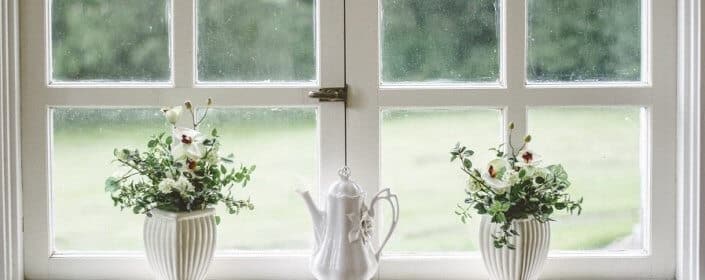A Look at Different Window Parts to Help You Understand Window Lingo
At first glance, a window seems like a relatively simple concept. But when breaking it down, it can be a little complex, especially when describing the individual components.
To better understand the different types and parts of a window, so you have an easier time shopping for residential windows, keep reading to learn more about window anatomy.
Different Types of Windows
Single-Hung Windows
Single-hung windows remain inside the frame and don’t protrude outward. They have one fixed window at the top and a bottom window sash that opens by sliding it upwards.
Double-Hung Windows
Double-hung windows are like single-hung windows but with two operable window sashes instead of one. These windows slide vertically up and down and can open wide from either the top or the bottom.
Casement Windows
Casement windows are hinged on the left or right side and open outward with the turn of a crank operating mechanism.
Awning Windows
Awning windows are hinged at the top, open outward, and allow fresh air in while keeping out the rain. These windows are often installed above, below, or beside a stationary or operating window.
Slider Windows
With at least one operating window, slider windows slide open horizontally on a track either over or past the neighbouring window pane.
Picture Windows
These large stationary windows don’t open, but they do maximize the amount of natural light that comes in, and they make for a great view of the outdoors.
Stationary Windows
Stationary or fixed windows don’t open, but they can be custom designed in any angle or shape to fit any space or architectural style of a home.
Transom Windows
These narrow windows are installed above a door or another window to allow in more natural light. Transom windows can be stationary or operable to let in fresh air.
Bay or Bow Windows
Both bay and bow windows protrude from the exterior siding of the house, allowing for more interior space. Bay and bow windows are a series of windows that can be a combination of stationary windows flanked by casement or double-hung windows.
The Different Parts of A Window
Window Frame
The window frame is the largest part of the window and is often made of wood. The frame is the shell that frames the opening in the wall, and it is what the window and window sash sit in. The window frame is made up of a head, sill, and jambs.
The head is the horizontal piece that sits at the top of the window frame. The sill (or stool) is the bottom of the window frame that protrudes from the window. And it is angled to shed water on the exterior of the window.
The apron is the horizontal board/trim underneath the sill that attaches to the wall. And the jambs are the vertical parts of the window frame that sit on each side of the window.
Window Sash
The window sash is the framework that holds the glass in place, is the moveable and fixed frame of a windowpane, and includes the rails and stiles. The rails help keep the glass in place and are the horizontal parts of the sash that connect to the stiles.
On double-hung windows, the middle of the window is called a check rail, and this is where the bottom part of the upper sash and the upper part of the lower sash come into contact.
The stiles are on the vertical parts of the sash and are located on the sides of the window.
On double-hung windows, the window sash slides up and down. On sliding windows, the sash slides side to side. And on casement and awning windows, the sash swings open.
Sashes can be tilted or removed for cleaning.
On fixed windows, such as picture windows and custom windows, the glass is installed directly onto the frames, so there are no moveable sashes.
Glass
Also known as glazing, this is the glass that sits inside the window frame and sash. Windows that are double-or triple-glazed have two or three sheets of glass instead of one to create a thicker, more energy-efficient window that reduces heat transfer.
These energy-efficient windows will use spacer systems to separate the glass panels. And the spaces between the panels will be filled with an insulating gas, such as argon gas.
A window can also have decorative coloured glass, which is similar to stained glass.
Muntins/Grilles
Sometimes the glass of windows is divided into smaller panes with decorative bars (muntins or grilles) that create a grid-like structure. The muntins or grilles can be on the glass or between the glass panels.
Weatherproofing
Weather-Stripping
Weather-stripping is used on window sashes to keep out moisture and prevent drafts and leaks. Weather-stripping is made from a flexible material to create a seal on the rigid surface of the window sash and frame that would otherwise make for an imperfect seal.
Flashing
Flashing is often made of aluminum or a plastic membrane. Flashing is a water-resistant material installed between the window frame and the rough opening in the wall. It keeps moisture out by ensuring the moisture runs off on the outside of your home’s finish material.
Spray Foam Insulation
Spray foam insulation is applied with an aerosol can and expands as it reacts with air. While expanding and drying, the foam turns into a stiff material to act as a protective barrier.
Spray foam insulation is used to fill in gaps between the window frame and rough opening, protecting the window and home from drafts and leaks.
Caulking
Caulking is a water-resistant material, often made from silicone. Caulking is applied to the exterior of window frames to help seal the window and prevent water from getting between the flashing and window frame.
Finishing Touches and Hardware
Casing
Casing is horizontal and vertical moulding that surrounds the window, covering the space between the window and the wall on the interior. The casing gives the window a finished look and creates a seal to prevent air transfer around the edges.
Brickmould
Brickmould is the exterior version of casing, providing a finished look to your window. Brickmould allows you to install a window into a rough opening without disrupting the exterior siding, stucco, or brickwork.
Balance
The balance in a window is a mechanical device that is usually spring-loaded and used in single-and double-hung windows to counterbalance the weight of the sash when opening and closing the window.
Operator
The crank or handle used to open and close casement and awning windows.
Scissor Arm or Extension Arm
The scissor arm is the part of the window that extends and contracts when you open and close a window with a crank mechanism.
Lift
The handle for raising the lower sash in a single-or double-hung window.
Lock/Latch
The lock or latch on a window is the locking device that locks the window and seals it tightly when closed, allowing the weather-stripping to block out the cold air and keep your home better insulated.
The lock on a double-hung window is located where the two rails meet. On a casement window, the lock is located on the stile. And on an awning window, the lock is located on the rail at the bottom of the sash.
Screen
Screens allow for ventilation while keeping insects out when the window is open. Screens can be made of woven plastic, metal, or fibreglass. And they have screen strikes, which are locks that hold the screens in place.
Now that you know the terminology and anatomy of windows, you can start shopping with a better understanding of the important lingo along with the key components.


